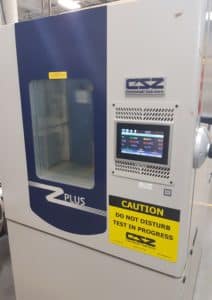ASTM D6944
Standard Practice for Determining the Resistance of Cured Coatings to Thermal Cycling
ASTM D6944 is now offered by Micom testing as part of its coating testing services. ASTM D6944—Resistance of cured coating to thermal cycling—describes two test protocols that evaluate the repercussions of repeated thermal stress on the adhesion ability of a coating system through the use of a thermal and humidity cycling test. In fact, this kind of test corresponds to a particular type of accelerated aging tests and they are somewhat similar to cyclic corrosion tests such as ASTM G85 . Indeed, they both use a cyclical procedure in order to induce the deterioration of the coating of the specimen, but they differ by the means employed to achieve this end. Lastly, this test protocol has to be paired with other coating tests in order to appraise the properties of the sample after the exposure, because the latter only provides the test conditions.
Evaluation of the adhesion resistance of a coating system following a thermal stress—use and factors to consider:
 The goal of ASTM D6944 is to determine the impact of thermal stress on the ability of a coating system to adhere to substrates by exposing the latter to a thermal cycling test. Indeed, this kind of test consists on exposing the sample to cycling test conditions as a means to identify the behavior of a certain attribute after the sample has been confronted to a simulated environmental condition for a predetermined period of time. As a matter of fact, this standard describes two different stress cycle protocols that assess the behavior of the coating towards this thermal stress. On the one hand, method A corresponds to a three-stage cycle that consists of a freeze, thaw and immersion period. On the other hand, method B is the same as method A, but it does not contain an immersion phase in its rotation sequence. Regardless of the method chosen, this practice only details the test conditions required for the thermal stress, but it does allude to other test protocols for the evaluation of certain properties. Therefore, it is essential to pair this standard with a practice that can appraise the right attribute. Lastly, the results obtained cannot be used to foresee the service life of the coating system.
The goal of ASTM D6944 is to determine the impact of thermal stress on the ability of a coating system to adhere to substrates by exposing the latter to a thermal cycling test. Indeed, this kind of test consists on exposing the sample to cycling test conditions as a means to identify the behavior of a certain attribute after the sample has been confronted to a simulated environmental condition for a predetermined period of time. As a matter of fact, this standard describes two different stress cycle protocols that assess the behavior of the coating towards this thermal stress. On the one hand, method A corresponds to a three-stage cycle that consists of a freeze, thaw and immersion period. On the other hand, method B is the same as method A, but it does not contain an immersion phase in its rotation sequence. Regardless of the method chosen, this practice only details the test conditions required for the thermal stress, but it does allude to other test protocols for the evaluation of certain properties. Therefore, it is essential to pair this standard with a practice that can appraise the right attribute. Lastly, the results obtained cannot be used to foresee the service life of the coating system.
The main factors that are to be considered when running this test are: the thickness of the film and the curing period of the coating.
Typical Experimental parameters for ASTM D6944 testing:
The number of samples required is two and it is recommended to test them alongside a material of known performance, so that the latter one can be used as a control. If the specimen is concrete, special arrangement has to be made in order to proceed with the method. The specifications of the test are listed in table 1.
Table I: Typical test parameters
| Parameters | Method A | Method B |
| Thermal cycling procedure | -5 °C ± 3 °C (23 ± 5 °F) for 16h (in air) 50 °C ± 3 °C (122 ± 5 °F) for 4h (in air) 25 ± 3 °C (77 ± 5 °F) for 4h (in tap water immersion) | -5 °C ± 3 °C (23± 5 °F) for 16h (in air) 50 °C ± 3 °C (122± 5 °F) for 4h (in air) |
| Curing period | 7 days at 23 ± 3 °C (73 ± 5 °F) | |
| Film thickness | Has to be specified | |
| Test length | 30 cycles | |
Other test methods related to ASTM D6944:
For additional related test methods, please see ASTM D3359 and ASTM D4541
If you have any questions about the ASTM D6944 test, we invite you to contact our material testing lab today. It will be our pleasure to answer your questions and help you with your custom material testing requirements.

